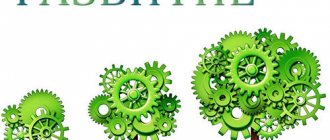Definition of the concept in psychology
The early postnatal period of fetal life in age periodization is called “newbornness”. It lasts from the first day of life until the moment when the baby develops a revival complex. As a rule, this occurs at the threshold of 2 months of life.
New birth is recognized by psychologists and physiologists as a crisis period in a child’s development, since he needs to adapt to new living conditions and adapt to the social environment. Having a basic set of innate reflexes, it develops new stable forms of response to external phenomena and events. In psychology, the revitalization complex is a kind of signal that the baby’s primary adaptation to society has been successful.
The first manifestations of the revitalization complex in a child appear at the age of 3 weeks. Its signs are:
- the baby’s ability to focus attention on objects and sounds;
- freeze when an adult appears and respond with a smile to his gentle voice;
- the ability to express joy with an enthusiastic cry.
For the first time, N.M. drew attention to the revitalization complex in a child. Shchelovanov at the beginning of the 20th century. He defined the essence of this phenomenon as the appearance of a set of emotional and motor reactions of the child to the actions of parents or other close relatives addressed to him.
Revitalization complex: when it appears
Normally, a revitalization complex should appear in a baby by 2.5 months. Until this time, the development of the child’s psyche gradually increases: the baby begins to see and hear better, recognizes his relatives and experiences his first attachments to people. The child, noticing movement or hearing a voice, turns his head towards the source of the sound or movement, carefully watches you, peers and listens.
By six weeks, the baby begins to smile when he sees or hears you. This is the child’s first communication with you in the initial period. The development of the psyche and the gradual decrease in muscle tone by 2.5 months allows the baby to express his emotions and “talk” to loved ones differently, more vividly and expressively - through the manifestation of the revitalization complex.
At what age does a neoplasm form?
With normal mental and physical development, the revitalization complex appears at 1 month. By the end of the second month of life, the revitalization complex includes all components:
- smile;
- concentrated look;
- active movements of arms and legs when an adult approaches;
- joyful cry;
- quiet melodic humming.
Situational animation in a baby is a primitive form of communication with others.
If the revitalization complex does not appear...
Since the revitalization complex is practically the first stage of a child’s mental development, a delay in its appearance for a long time or its complete absence during this important period will indicate the presence of pathological conditions of the nervous system in the baby.
If by 10-12 weeks the baby has not noticed a baby revival complex, he does not happily wave his arms and legs when you appear, does not recognize you and does not smile when you appear, contact a neuropsychiatrist. A slowdown in mental development or the absence of emotional components when communicating with loved ones in a child during this period may signal that he has a developmental delay or even autism.
The absence of a revitalization complex is not a death sentence. Together with a specialist, you will help your child with activities and therapy to adjust the rate of maturation of his nervous system.
Stages of the revitalization complex
For the timely appearance of a revitalization complex in a baby, it is necessary to create a favorable psychological environment for him from the first days of the child’s stay in the new home. It should be remembered that newborn children need peace and quiet no less than attention and affection. It is recommended to exclude strong emotional shocks in the first month of life.
Some parents get upset when they don’t get the desired reaction from their baby to a bright rattle or musical toy. It will not be possible to artificially evoke emotions in a baby, since physiologically he is not yet able to show them. You need to wait, it will only take a few weeks, and the child will appreciate the toys and rattles. This will happen as soon as the baby develops a revival complex. The emergence of a revitalization complex indicates the toddler’s readiness to understand the world around him.
The revitalization complex includes the following stages:
- The appearance of a whole set of new reactions, which in psychology are called the revitalization complex, namely:
- The baby freezes when he sees a new object for the first time or hears a familiar voice.
- Visual and auditory focus on an adult's face or voice. Examining an approaching adult, the child is able to look into his eyes and hold his gaze.
- Smile and enthusiastic screams.
- With the help of loud screams or prolonged humming, the toddler attracts the attention of an adult and asks for communication.
- Motor activity, with the help of which a little person tries to express his need for physical contact with his parents. He reaches out his hands to his mother, turns his head, arches his back, throws up his arms. As soon as his mother takes him in her arms, he cuddles up to her and hugs her neck.
- Almost immediately after the appearance of a set of emotional and motor reactions, the child begins to differentiate voices, unmistakably identifying the mother’s voice among them.
- Focusing on attractive bright objects. Now he is able to follow a moving object with his eyes. This ability occurs approximately 2 weeks after the end of the neonatal period.
- By the end of the second month of life, positive emotions in the child are evoked not only by the mother’s face and her voice, but also by her touch and breastfeeding. The baby is happy when his mother is nearby.
- By the end of 3 months of life, the revitalization complex changes. New, more complex forms of behavior emerge. Based on the revitalization complex, by about 4 months the baby’s ability to divide people into “friends” and “strangers” develops. This is manifested in his wariness towards strangers, in differentiating the facial expression of an adult. In addition, the revitalization complex marks the emergence of such a need as knowledge of the surrounding world. No matter how attractive the surrounding reality may be, if the child is not psychologically ready to study it, he will not show interest in surrounding objects and phenomena.
The main signs of the revitalization complex.
Practical lesson 3
Topic 2.1 Mental development of a child with disabilities in the first year of life (infancy)
Answers on questions
General characteristics of the newborn period.
The neonatal period, which begins from the time of physical separation of the child from the mother, is the time of improvement of the reflexes given to him at birth and adaptation to the conditions of the surrounding world. Unconditioned reflexes, such as breathing, sucking, protective, grasping and orientation, help him survive in the first minutes after birth. The “baggage” of knowledge and skills is small, especially since the grasping reflex is a gift from the ancestors, which soon disappears as unnecessary, and although the sucking reflex exists, the child has to learn the actual process of sucking.
A newborn child is helpless not only because he does not have the ability to satisfy his needs on his own, but also due to the lack of well-developed behavioral acts. It is also not adapted to changes in temperature, since it lacks thermoregulation. Because of this, you need to bathe your baby extremely carefully in the first days of life, carefully measuring the temperature of the water and gradually immersing him in the bath. The water temperature should be practically no different from body temperature, that is, not exceed 36–37°C.
A newly born baby sleeps a lot. Even the time of wakefulness can be called conditional, because he is half asleep. Sleep time is not regulated in any way and is not connected with anything. For a child to stop sleeping during the day and begin to rest only at night, you will have to wait a sufficient amount of time, so the young mother needs to be patient and learn to get the hours of sleep she needs to fully recuperate while the child is sleeping.
Conditions of infant development.
The life of a baby depends on the adults caring for it. An adult, moving a child in space, provides him with a variety of visual, auditory, tactile and other sensations. The child’s contact with reality is carried out directly through an adult: he brings various objects to the child’s eyes for examination, knocks with a rattle, and for the first time puts an object in the child’s hand to grasp. There is almost no need that a child could satisfy without going through an adult.
The adult appears to the child as the central element of the surrounding reality, as the center of every situation.
Social reactions increase during the first year of life. In the second half of the year, these reactions reach their maximum frequency.
At the age of 3-6 months, a selective attitude towards adults appears. A three-month-old child distinguishes his mother from others, a six-month-old child distinguishes strangers from his own. While 3-4 month old children smile and perk up when any adult speaks to them, 5-6 month old children, if a stranger approaches them, first look at him for a long time and intently, and then may smile, or turn away, or cry.
In the second half of the year, attachment to close adults continues to grow. The child can observe children and adults in his field of vision. At 8-9 months, the child’s first games with adults begin. The child's joy is associated with the participation of an adult in these games, and only then does the game itself begin to provide pleasure. In the last months of the first year, children not only closely monitor the actions of adults when they are busy with work, but gradually turn to them for participation and help.
Until one year of age, a child’s smile appears almost exclusively on a human face or voice. The buzzing is caused by the same thing. Turning toward sound occurs first of all in response to the human voice, then in response to other stimuli. A child imitates only a person.
Development of the infant's receptor and motor spheres. Reflexes of a newborn.
Development of the infant's receptor and motor spheres
During the first two months of life, the child’s eye movements intensively develop, while differentiated hand movements are still absent. The act of looking develops in this way: at 2-3 weeks, convergence of the eyes appears, but it is still very difficult for the child to stop the gaze on an object; at 3-5 weeks there is a delay of gaze on an object, although very slight; at 4-5 weeks the child can already follow an object at a distance of 1-1.5 m; at 2 months he learns to follow an object located at a distance of 2-4 m, and at 3 months. – at a distance of 4-7m; in the period from 6 to 10 weeks, the child already follows an object moving in a circle. By four months of life, the act of looking is already sufficiently formed.
The ability to direct the movements of the hands to an object and feel it appears only in the fourth month, and grasping an object occurs only between the fifth and sixth months.
Thus, the development of the hand - both as an organ of action and as an organ of touch - is delayed compared to the development of vision. Sitting, standing, crawling and walking develop even later, in the second half of the first year of life.
The importance of different analyzers in the development of movements is different. In an infant, the predominant role is played by external analyzers - partly skin, and mainly visual and auditory. Internal analyzers - muscular-articular and vestibular - in an infant usually work under the predominant influence of external ones.”
Thus, the general principle of child development is the early inclusion of the cerebral cortex in the process of formation of all basic forms of child behavior. The order of development of movements is not hereditarily fixed, but depends on educational influences. One child may begin to sit first and then stand, while another may experience the opposite (the same applies to crawling and walking).
The development of the eyes by the fourth month of life allows the child to only follow a moving object. There is still neither movement of the eyes themselves on the object (examination), nor visual search for the object.
The development of the hand as an analyzer begins with the appearance of palpating movements in the child in the fourth month of life. First, he feels his hands, then he begins to feel the diapers and blankets. The fundamental content of this reaction is that the hand moves not behind the object, but along the object.
By five months, the act of grasping is formed. At the beginning of the formation of this act of grasping, the actual act of grasping does not yet exist, because the child reaches for an object without the typical position of the hand for grasping and does not hold the object.
The act of grasping:
· associated with the formation of visual-motor coordination;
· represents the first directed action;
· is an important condition for the development of a wide variety of manipulations with an object.
The development of hand-eye coordination is also associated with the fact that by the sixth month of life, the child can already sit up independently. By seven months, the connection between the perception of an object and the movement to grasp it is established almost instantly: by seeing the object at an accessible distance. The child immediately points his arms towards him and grabs him. The act of grasping itself is performed with the thumb in opposition to all the others. During the second half of life, manual movements especially develop.
The orientation reflex takes on the character of a particularly strong reaction to something new. The experimenters offered the child some new object (a cube, a cylinder - of different sizes and different colors). The object evoked a strong orientation reflex in the child. After the child had the object for 15-25 minutes, it was taken away and then given in combination with another object that differed in color or shape. It was found that with such repeated presentation of the “old” object together with the “new” one, the child reacts predominantly to the “new” one.
The stimulating nature of “novelty” for the activities of a child of this age makes it possible to understand the mechanism of repeated and chain actions, including active viewing associated with the manipulation of an object. Such consideration consists in the fact that the child places the object in more and more new positions until the “novelty” of the object is exhausted and the orienting reflex to it fades away.
In the process of forming repeated and chain actions, the child develops certain ideas about the properties of objects and the possible result of actions with them. Subsequently, the child learns to manipulate two objects at the same time, and he begins to perform the first functional actions with these objects. Almost until the very end of infancy, imitation and other forms of learning are of little importance in the child's acquisition of new actions.
At the end of the first year of a child's life, it is difficult to teach any imitation action.
With the formation of objective actions, the latter acquire decisive importance in the development of the cognitive sphere. Direct, practical contact with objects, actions with them lead to the discovery of more and more new properties of objects and relationships between them.
By the end of the first year of life, the development of the child’s locomotion and movement in space is also of particular importance. By the end of the first half of the year, the child can already sit independently.
In the second half of the year, the ability to stand first with support on an object is formed. And then without support. Finally, by the end of the first year of life, walking appears, which is extremely important for the entire subsequent development of the child. The acquisition of a vertical body position significantly expands the child’s range of perception of the surrounding reality and the possibility of active resistance with objects that were previously out of reach.
The emergence of the ability to roll over from one side to the other, the ability to see, stand, and the rudiments of walking expands the child’s active orienting activities in relation to objects in the outside world.
Basic reflexes
During this period, the baby develops only unconditioned reflexes - that is, those that are laid down as if by default. Gradually, some of them disappear, giving way to conditional ones.
Conditioned reflexes can also be called the “personal experience” of a child, since they are acquired in the process of further development and maturation of the brain.
The main signs of the revitalization complex.
In the period from four to six weeks, the child, who has already learned to identify an adult with the help of his mother, quickly masters a variety of means of communication. The baby now confidently looks for the adult with his eyes, turns towards the sound of his steps, notices him from afar at a great distance. He intently examines his mother’s face (her eyes attract special attention) and listens to the sounds of her voice. In response to his mother's calls, he smiles, looks at her carefully, animatedly moves his limbs and makes a variety of sounds.
The picture of the baby's joyful behavior was called by scientists the “revitalization complex.” The revitalization complex includes four main components: 1) freezing and visual concentration - a long, intent look at an adult; 2) a smile expressing the child’s joyful emotions; 3) motor revival - head movements, throwing up arms and legs, bending the back, etc.; 4) vocalizations - screams (loud abrupt vowel sounds), hooting (quiet short sounds like “kh”, “gk”, etc.), humming (long-drawn sounds reminiscent of birdsong - “guulllii”, etc.).
All these components are observed in the infant’s behavior simultaneously (hence the name “complex”). The revitalization complex develops at about two months, and its intensity increases until four months. After this age, the revitalization complex begins to “disintegrate,” that is, its individual components become relatively independent and new forms of child behavior arise.
The revitalization complex is a unique manifestation of pleasure in response to influences from adults. For a long time, the revival complex was interpreted precisely as a reaction in response to the actions of an adult.
However, recent research has made it possible to look at this phenomenon as a form of active participation of the infant in communication with an adult.
What should a child be able to do after 4 months?
The psychophysiological meaning of the revitalization complex becomes clear when neoplasms appear at 4 months of life:
- ability to respond to one's own name;
- interest in your own body, which is expressed in looking at your hands, touching your face, hair;
- interest in your reflection in the mirror;
- the beginnings of object-manipulative activity;
- the ability to recognize a familiar object, be surprised at its disappearance from sight and rejoice at its sudden appearance;
- ability to independently roll over from back to tummy and back;
- ability to sit with the support of an adult and keep the head upright in a sitting position;
- the ability to push off from a horizontal surface with the tips of the toes when an adult holds the child by the body;
- ability to clap hands;
- the ability to correctly recognize basic emotions.
The current situation of the personal development of an infant at the 5th month of life includes improved constructs of the revitalization complex. Psychological components, which include the revitalization complex, gradually disappear in a child older than 4 months.
Basic patterns of age development
Page 4
The absence of a revival complex or its paradox, for example the appearance of fear, screaming and other negative emotions, is characteristic of children with emotional disorders - early childhood autism, early childhood nervousness and other disorders.
Since the revitalization complex is formed in close connection with the development of vision and hearing, if these analyzers are defective, it may be absent or appear in a rudimentary form. With congenital blindness or deafness, and especially with a combination of these defects, the revitalization complex is absent at this age stage.
If the damage to the central nervous system is not pronounced, in children who have suffered birth trauma, asphyxia, neonatal jaundice, as well as in premature and immature children, the revival complex appears at a later date. It may also be absent in children raised in conditions of emotional deprivation.
In the third period (3–6 months), the reactions included in the revitalization complex become increasingly differentiated. A child over 4 months old, when an adult approaches him and tries to make contact with him, carefully peers into the adult’s face, opens his eyes and mouth wide, and slows down general movements. Thus, he exhibits an indicative reaction, which in some cases turns into joyful animation, and in others gives way to fear and screaming. It should be noted that the fear reaction at this age stage does not appear in all children. This depends on the individual characteristics of the child, as well as on the conditions of his upbringing and environment. Excessive severity of the fear reaction at this age stage is typical for children with increased nervous excitability and early childhood autism. It may be the first sign of congenital childhood nervousness, mild brain dysfunction, and increased intracranial pressure due to hydrocephalus. It is also common in children with cerebral palsy.
The lack of differentiation of the revitalization complex at this age stage is characteristic of delayed psychomotor development, including due to insufficient communication between adults and the child. Differentiation of the revitalization complex occurs earlier in children raised at home than in children in institutions.
Towards the end of this age stage, the child begins to recognize the mother. True, this reaction is still very unstable, and its appearance depends on many conditions, so its absence does not have independent diagnostic significance. However, if a child recognizes his mother, this indicates the child’s good mental development.
To assess mental development at this age stage, it is important to monitor how the child reacts to the toy. The leading form of activity at this age is toy manipulation.
The child not only fixes his gaze on the toys for a long time and follows their movement, but directs his hands towards them, grabs them, and pulls them into his mouth. This is accompanied by expressive emotional reactions: he either smiles or frowns.
By the end of the period, the nature of visual tracking changes. If previously children followed the object without taking their eyes off, and having let the object out of sight, they did not return to it, then after 5 months the child, watching the object, seems to “feel” it with his gaze; If at the same time his attention is switched to another object (an adult’s face), then after a second he can return to actively examining the toy. The manifestation of this function is a very important indicator of normal neuropsychic development.
During this period, vocal reactions develop intensively and begin to acquire some independence. Along with melodious humming, babbling appears by the end of the period, as well as selectivity and differentiation of reactions to sound and the ability to localize sound in space.
In the development of hand movements, the visual analyzer begins to play a leading role: by the end of the period, the child quickly and accurately directs his hand to a toy located in his field of vision.
At the next fourth stage of development (6–9 months), when a child communicates with an adult, an indicative reaction is clearly manifested, which is replaced by a reaction of joyful animation to familiar faces and a reaction of fear to unfamiliar ones. In some cases, one can observe how the indicative reaction turns into cognitive interest, bypassing the fear reaction.
A distinctive feature of a child’s mental development at this age stage is his readiness to manipulate a toy together with an adult. In addition, by the end of this stage, the child develops the initial elements of communication with an adult using gestures. He stretches out his hands to an adult, indicating that he wants to be held, or reaches out with his hands to a distant object if he wants to receive it.
Pages: 4
Other articles:
Features of burnout syndrome in representatives of certain professions Professional stress is a multidimensional phenomenon, expressed in physiological and psychological reactions to a difficult work situation. The development of stress reactions is possible even in progressive, well-managed organizations, which causes ...
General concept of sensation The simplest of cognitive mental processes is sensation. The process of sensation arises as a result of the influence on the sense organs of various material factors, which are called stimuli, the process of influence itself is an irritation...
The student as a subject of educational activity. Psychological characteristics of late youth (18-25 years old) - maturity in mental and moral terms. ü Peak intellectual capabilities ü Stabilization of character ü Confidence, established worldview ü Feelings...
The meaning of the phenomenon
At about 6 months, it becomes clear why the child needs a revitalization complex: the baby begins to attempt conscious, purposeful interaction with people. In the process of communication, the child uses intonation, posture, gestures and facial expressions. In addition, situational business communication, which begins to develop from 7–8 months, includes all the components of the infant revitalization complex. Daily varied communication and exposure to various objects stimulates the baby’s personal development.
The formation of a baby’s situational and personal development is directly dependent on how many months the baby’s revitalization complex was discovered and whether all the components were sufficiently clearly represented in it. The absence of one or another structural link in the overall revitalization may be a sign of deviations in the mental development of the baby. The untimely appearance of an emotional reaction or its absence in a child is a reason for an immediate visit to the doctor.
Basic baby skills after four months
In addition to physical development, during this period it is important that the baby has the following skills:
- Ability to roll over independently, without the help of an adult.
- Keep your head in a prone position on your stomach.
- Sit down with the help of an adult (when he is lifted up by his hands), keep his head in a sitting position.
- Ability to push off with the tips of the toes from a hard surface when held by the armpits.
- In contrast to two months, when the revitalization complex manifests itself, the period after four months is characterized by conscious grasping of objects with open palms, with which the child can independently pat objects.
- The ability to purposefully put your fingers in your mouth instead of a pacifier or help yourself with your hands when breastfeeding.
The older the child becomes, the less noticeable the main manifestations of the revitalization complex are, although some of the reactions, on the contrary, become conscious and significant.
Relationship between parents and children
A close emotional connection between parents and child begins to form from the first days of the appearance of a new member in the family. First, it is based on satisfying the physiological needs of a small person. Children quickly learn to use age-appropriate ways to attract an adult's attention.
Emotional contact between parents and infants is the key to normal mental and personal development. Trusting relationships in the family give the child a feeling of safety and security. Subsequently, a child who did not experience a lack of communication in infancy becomes inquisitive, independent, proactive, and purposeful.
My advice to new parents
Sometimes parents neglect to satisfy their children’s need for communication, believing that physiological comfort is more important for the baby. Young parents often do not know how to communicate with their baby, believing that he does not understand anything yet.
I would like to wish young married couples to learn to appreciate every moment spent with their child. Affectionate words, stroking, kisses, mutual smiles - this is how we can briefly list the main components that stimulate the opening of the revitalization complex.
The child laughs in response to his mother’s kiss - which means he needs to kiss him again! The baby hums protractedly, calling his mother - you should gently sing something in response, gently leaning towards the baby! The baby is in a good mood - it's time to tease and tickle him!
Disorders of personal development in childhood. article
Disorders of personal development in childhood.
Personality growth disorders are extremely common in both childhood and adulthood. It often turns out that behind one or another violation of cognitive processes (lag in the development of mental abilities in a child, etc.) lies a violation of personal development.
Perhaps this is based on the fact that in practical pedagogy more attention is paid to the development of cognitive processes rather than personality. Attempts at purposeful personality formation often come down to explaining to the child that he must perform moral actions and experience moral feelings. Such circumstances cause various psychological problems or even developmental deviations.
The concept of deviations in personal development covers a wide range of phenomena:
formation of antisocial motivation,
the appearance of emotional disturbances (fears, aggressiveness, etc.) and disturbances of the volitional sphere (weak will, whims, stubbornness, negativism),
low level of social competence, etc. Disorders of personality formation, both in emotional and other areas, can be conditionally divided into two classes:
- specific to a certain age stage (for example, the absence of a revitalization complex at two to three months is a serious obstacle to the further development of the child, just as the absence of this phenomenon, for example, at two to three years cannot be considered a negative developmental phenomenon);
- nonspecific (general) - such disorders at any age are considered subject to correction, for example, lack of situational emotions, etc.
The conditionality of this division is that both types of violations are parties to the same process. However, like any typology, this division allows a more analytical approach to the study of violations.
Here are a number of specific manifestations of emotional disorders in childhood, which are indicators of deviations in personal development.
Thus, in infancy, emotional personality disorders are:
lack of a “revitalization complex” that determines emotional development (this disorder is diagnosed at the age of four months, since earlier this may be due to individual characteristics and does not indicate negative development of the child);
delay in the appearance of various forms of external expression of emotions, absence of clear facial reactions, in particular, a smile, which normally appears at three months;
inadequate emotional reaction to the action of an adult (for example, crying in response to the mother’s caring actions, stroking, etc.);
apathy and indifference of the child in a situation of interaction with another person, in particular, a caring mother; In the second year of life, emotional disorders are:
absence of emotional contamination, which appears in infancy and serves as the basis for a child’s communication with an adult. The absence of syntony in the second year of life can be considered a serious anomaly in the process of personality development;
high intensity and duration of emotional infection, “stuckness” of the emotional process, which normally arises and disappears quite quickly in a young child;
lack of clearly differentiated emotional reactions to different people. Thus, a child with normal development of the emotional sphere experiences positive and more intense emotions when communicating with loved ones, primarily parents. Normally, by the end of the first and second year of life, the most important condition for the development of sympathy for another person is the level of activity of this person in joint activities with the child. There is a fairly close relationship between activity level and sympathy. Emotional relationships become more differentiated and stable, although communication still retains a situational nature. Thus, the affection of the same person who is attractive to a child can in one case please, in another (if, for example, it distracts from a pleasant activity) cause dissatisfaction or opposition;
lack of positive emotions when new toys appear;
fear of safe objects (not large, not sharp, etc.) and excessive caution. In general, caution is not characteristic of young children, which necessitates the need for adults to monitor the child’s actions. The appearance of caution at an early age does not indicate the early development of this characteristic, but rather an emotional disturbance, since it is based on different processes than the caution of adults;
emotional fixation on any one object (for example, some toy). Positive emotions when manipulating an object are a sign of the normal development of the emotional sphere of a child’s personality, but if a child experiences joy only when only one object appears, then this can be considered a manifestation of an emotional disorder. Such emotional fixation must be distinguished from the child’s desire to repeat successful actions, which is considered completely normal and even necessary in the development of the child, since it is a manifestation of the child’s desire to prolong pleasure. When a child achieves a good result, it leads to repeated attempts in order to repeat the pleasant result of the activity again and again and experience positive emotions from his success. This helps to consolidate various useful skills;
depression, the duration of which is not adequate to the strength of the impact. So, if a small unpleasant event (“slap” from parents, etc.) plunges a child into a long-term emotionally negative state, then this indicates a violation of emotional self-regulation, which should help get rid of situational negative emotional reactions (anger, apathy, etc.) ;
ambivalent behavior. It can be observed at an early age and later. A child’s ambivalent behavior is considered normal if it appears in situations of social restrictions on meeting needs (situations of “I want to, I can’t”). Outside of such restrictions, ambivalent behavior is a sign of disorders of personal development. The basis of this behavior is the struggle of motives. For children of early and preschool age, this phenomenon is not typical, since the struggle of motives in these children can be ascertained only in the presence of external social stimulation (when, for example, an adult offers the child a choice of two equally pleasant, even mutually exclusive actions). Ambivalent behavior occurs in cases when the child “throws around”, does not know what to choose, hesitates whether to take an object or not, while showing restlessness, anxiety and other similar emotions;
indifference and apathy of the child. Most often it is caused by social and emotional deprivation. Elimination of deprivation restores normal development of the child.
In preschool age, emotional disorders include the following phenomena:
lack of emotional decentration, which manifests itself in the inability to empathize with another person either in a real situation or when listening to a fairy tale. Normally, a child listening to a fairy tale identifies himself with the main character and experiences all the conflicts with him. These experiences are quite clearly manifested in nonverbal behavior. The lack of emotional decentration in itself is a negative phenomenon, but it also negatively affects the development of prosocial motivation and “unifying” feelings that regulate interpersonal relationships.
The absence of emotional decentration is a more reliable indicator of emotional disturbance than inertia, the fixedness of the emotional coloring of the reflected content, already due to the significant individualization of the dynamic characteristics of the emotional process. Naturally, a child who has less mobility in the processes of excitation and inhibition will also be emotionally “stuck.” Accordingly, the diagnosis of the deviation is complicated, because regular “emotional inadequacy” can be considered as abnormal only when correlated with the individual characteristics of the neurodynamics of mental processes.
Lack of emotional anticipation can be considered an indicator of deviation. Without returning to the past, shame, remorse, etc. cannot arise. Without emotional anticipation, it is impossible for even the minimum of voluntary regulation that is required in role-playing to occur. The underdevelopment of the internal plan of action in preschoolers limits the range of temporal shifts, so we can talk not so much about the degree of expression as about the very possibility of emotionally highlighting the future (and then the past) or the child’s ability to understand the desires of another person;
lack of syntony. Syntony is understood as the ability to respond to the emotional state of another person (first of all, a “close” or attractive person). Synthonia appears towards the end of the first year of life, but is a sign of normal personality development not only in early, but also preschool age;
the absence of a specific phenomenon of emotional self-regulation for preschool age “feelings of guilt” associated with a new type of self-awareness (“I did this”) and the ability to emotionally return to the past;
many negative emotions and phobias of the child, coloring various situations. So, in preschool, as at any other age, in addition to the indicated emotional disorders, these include isolation, fears and aggressiveness.











